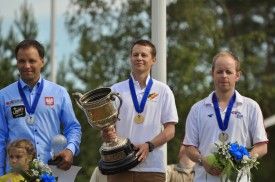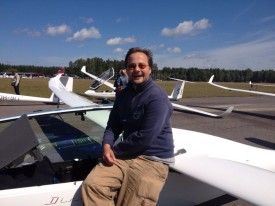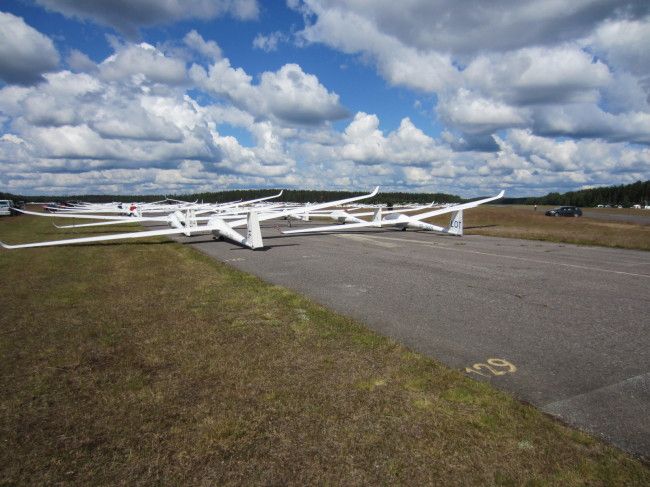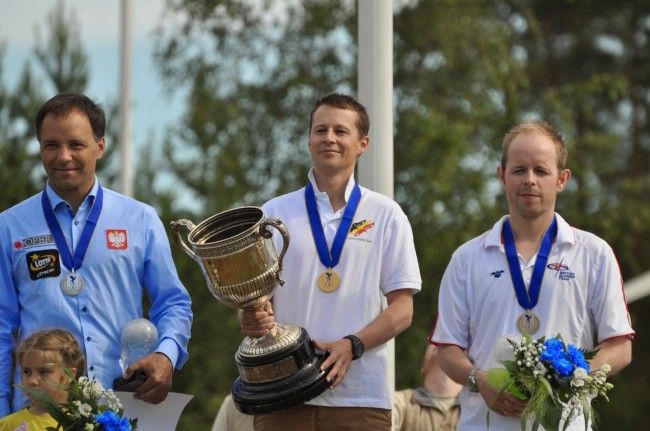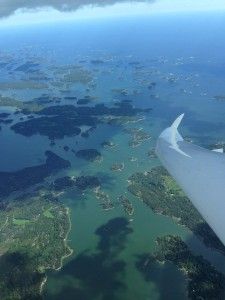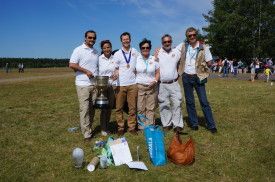Bert Schmelzer answers Soaring Café’s Questions
Bert Schmelzer answers Soaring Café’s Questions
Bert, you are the first Belgian glider pilot ever to become a World Champion. What a feeling?!
Even three weeks after the competition is over, it is still difficult to realize what it exactly means to be World Champion, but I can tell you that crossing the finish line on the last day of a WGC, realizing that you have just become the winner of the 33rd World Gliding Championships, is a very rewarding feeling. The next day this changed to feeling proud and grateful at the same time. I could find my name on the cup which has so many famous pilots’ names already on it – Huth, Reichmann, Renner, Brigliadori, Selen, Davis, Aboulin, Kawa, … just to mention a few.
Have you flown a WGC before? Where? In which class?
So far I’ve participated in 4 Junior WGCs and 2 Senior WGCs, of which the last was in Prievidza 2010. Since 2006 I fly standard class in my beloved Discus 2a “21”. My brother and I share this glider and we move it back and forth between Belgium and Switzerland during the season.
You never won a single day but constantly moved up in the overall scores. “Würfelwetter” (German expression for rolling the dice in difficult weather conditions)? The last day was probably a head to head race between the first placed pilots?
I’m not the kind of pilot who is only looking for day’s victories. It is a waste of time and energy. I always keep the overall result in mind (but of course I won’t hesitate to win a day if possible ;-). Consistency, especially during difficult days, leads to winning a competition, going like a yo-yo through the daily score sheets won’t. During this contest our team found a very good balance between racing-mode and being precautious not to ruin the main objective, i.e. being on the podium at the end.
In a European or a World Championship there is no such thing as luck, especially if you get more than 5-7 days of flying. Have a look at the top-ten in the final results, and you will see many well-known pilots, who performed remarkably consistent, over a wide range of weather types and tasks. So the beautiful German word “Würfelwetter” seems to be cancelled out when you have a contest with enough days to score.
Personally, we had a very good competition start, and after the second day I moved up to first place. Unfortunately, we made a huge mistake (the only big one…) on the third day. It cost us about 175 points. That evening I thought it was all over. But thanks to the strong support from everyone in the team and – equally important – a strong will to make it back on the podium, we had a fantastic second half of the competition. We flew with a lot of confidence and didn’t make any more big mistakes. Especially on day 5, when only Kawa, Krok and I made it back home, I realized everything was still possible. It was an interesting day which seemed to die about a dozen times including wave, strong energy lines, sea breeze inflicted blue parts, 50km/h of wind, thunderstorms, cirrus overcast and turn points in rain showers. Despite being as low as 140m AGL in heavy rainfall, I never really doubted to make it back home. It was exactly the confidence boost I needed to jump back onto the podium.
On the penultimate day I took back the lead of Sebastian, with a tiny margin of 8 points (about 45 seconds). The English pilots were 58 points behind us, so there was everything to play for on the last day. Needless to say I was a “bit” more excited than ever before.
Without your brother the “coup” would not have been possible? You were a great team. How did he support you, or did you support each other, and how could you decide who of the two brothers gets the chance?
My brother, Tijl, and I have been practicing our team-flying skills a lot in the last couple of years, mainly during high-level competitions like the Belgian Nationals, Hahnweide, World and European Championships. I guess we complement each other very well: I fly a bit more with intuition and he is a mathematical genius. This combination proves to be very efficient. But most importantly: we are brothers, so we trust each other for 100% and we don’t even care who will grab the title. We always aim at having one of us on the podium and if possible both. In Räyskälä there was another pair of brothers competing in standard class (Jez and Richard Hood) who became 3rd and 4th. They seemed to work together in a similar way. Tijl and I don’t wait if one of us is lower, but we keep sharing a lot of information and always understand exactly what the teammate is talking about.
It is extremely important that we take our own decisions as a team. We basically don’t care what other pilots are doing and are pretty confident about our flying and decision-making. Even on the final day we didn’t stop racing and had a fantastic battle with the three Polish and the two English pilots. Every 50 km another team was leading the race and in the end we all finished more or less together. A very exciting day!
“Never stop exploring”: You haven’t been to Finland before, right? Did you use the WGC as an opportunity to discover a new place?
After my brother had participated in the Junior WGC in Räyskälä (2009), he told me about high cloudbases, strong thermals and endless cloudstreets above a beautiful landscape. Needless to say I was looking forward to experience this myself. The weather we had was quite different, but at least we saw a couple of those booming days.
Of course we all followed the weather news in Räyksälä, it must have been disappointing?
Actually, not at all! Even though we had lots of rain showers, even some snow, we enjoyed every flight with its challenges to the utmost. It was tremendously exciting to experience a huge variety of weather conditions, sometimes during one single flight. I firmly believe it is extremely important to keep a positive attitude during the entire competition and in the end have in mind that the weather is the same for everyone. Interestingly I never had any doubts about which route or option there was to take, regardless of how difficult the weather was. Our decisions were all very straight-forward. Maybe this gave us the margin on the other competitors.
Could you at least enjoy some international camaraderie during the rainy days?
Competing at a Worlds is one of those special occasions where you meet a lot of old and new friends. The organizers did everything to re-enforce a nice atmosphere between participants, crews and locals. They organized some well visited events. Especially the traditional international evening was a huge success.
Thinking of your book and those wonderful pictures in the web: Were you able to shoot some new fantastic ones?
Unfortunately I don’t have time to take pictures during a competition flight. I make a big difference between training or recreational flights and flying competitively. During the latter ones I only focus on the competition and there is nothing else to spend time or energy on.
Southern Finland looks pretty flat, mostly forested. At your Swiss airfield you are used to more mountainous terrain, in Belgium there are not as many forests… How did you like the competition area?
Flying and training mainly in mountainous terrain helps me to better understand wind-related phenomena and cloud shapes. These are key factors during a flight in the mountains, and – to a certain degree – they are transferable into flatland flights. A major training asset is the OLC-League which we strongly promote in my Swiss club. Every weekend we have some very good pilots racing together and against each other in a time frame of 2.5 hours.
Well, I learned to fly in Belgium and still today I prefer to fly competitions in flatlands, even though I have about 1.500 hours of experience in mountainous terrain. It is true that the northern part of Belgium doesn’t have that many forests, but our Nationals take place in the Ardennes and the Eiffel, where some areas are covered with woods. So Tijl and I know how to handle these conditions and sometimes scarce outlanding possibilities.
During the worlds we didn’t have a problem with forests or lakes because we always tried to fly with a backup plan. We never took risks. The cloudbase usually was high enough to cross lakes and forests in a safe way. As far as I know, no glider was damaged during the contest.
How did you prepare for this WGC?
I’ve been a part of the Belgian national team for quite a few years, and due to a very good atmosphere within the team we encourage and support each other. This is probably different compared to some of the bigger teams, which can suffer from internal rivalry. Knowing that lots of people support what you are doing before and during the contest gives a reassuring feeling.
Every year, I fly two big competitions, mostly Hahnweide or the Belgian Nationals plus a WGC or EGC. The first one basically is training for the Worlds or Europeans and a possibility to sharpen our team-flying skills. We always try to fly in a class with strong contenders, to increase the training effect. If time permits, I participate in at least one regional competition during the weekend, to stay in competition mode throughout the season or just to have fun with good friends.
During the regular soaring weekends I don’t fly as “on the edge” as during a competition, but every flight is a training flight to me, including a declared task, efficient climbing and gliding plus a proper final glide. I’m very lucky to fly on two airfields (Keiheuvel / BE and Hausen am Albis / CH ) where a lot of strong and competitive pilots are around. They are always in for a friendly race.
The non-flying part of my preparation for Räyskälä includes a thorough study of IGC-files, soil types in the competition area, reading reports of former local competitions, looking carefully at the airspace files, … All of this helps me to focus completely on the flying part during the contest.
Organizing and hosting a rainy WGC must be tough. ~120 teams were suffering from cold and wet conditions. Did you receive support from the locals out there in the middle of nowhere?
It was the first time I’ve been to Finland and I was surprised about the friendliness. The locals made us feel very welcome. Whether on the airfield, in the bar, in Helsinki or in a tiny village, they always tried to find a solution, for any problem. Competition director Heikki and his team did a fantastic job and it was the first time I’ve been to a contest where the C.D. got a standing ovation during the final briefing.
Anything else you would like to mention?
I would like to thank everyone for the massive support during, and the uncountable congratulations after the contest!
We had an amazing time in the “country of 1.000 lakes”: beginning with snow on and antifreeze in the wings on the longest day of the year, many difficult flying days with lots of rain showers and unsuccessful fishing expeditions in the middle part of the comp. Finally we were rewarded with fantastic conditions and exhilarating final glides during the decisive tasks.
Without the help of my parents, Hilde and Bert Sr., and of course my girlfriend, Barbara, all this would not have been possible. Thank you so much! In particular I would like to thank my brother, Tijl: “Little brother, unfortunately, there can only be one person on the highest step of the podium, but this title belongs to the both of us !”
Bert, thank you very much for the interview. Enjoy your upcoming party in Keiheuvel!

